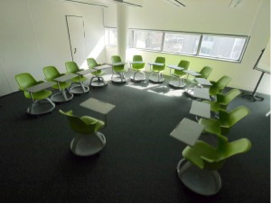Looking for creative teaching activities? Encourage students to work collaboratively and motivate each others learning, to clarify their understanding of course content and reflect on different peer perspectives. Take a look at the group work suggestions in our series of blog posts. We recommend booking City’s new Learning Spaces to run these activities.
1) Rounds
Why? A useful icebreaker or method to wind up a session. A personal focus can mean a positive start to the session and is inclusive of everyone. Be sure to offer students some choice about what and how much to share about themselves so that they feel comfortable and in control.
Technique; For groups smaller than 20. Ask some simple questions. Sit in a circle and go round the circle asking each student to answer. Suggested examples;
* Add a key term from the course title to the board and ask students to think of the first idea that it brings to mind.
* Ask students to give their name and provide a memorable fact about their name.
* Ask students to share something good or new that they have learnt in the last 24 hours.
* Write a fact on the board (it could be relating to the course). Ask students to guess what the question was that matches the fact e.g. Fact: Croatia, Question: Where did I go on holiday this year? Where have a worked? Go round the circle until the correct question has been discovered. Students could then be placed into small groups to repeat the same activity.
Online suggestion; You can replicate this activity online via a discussion forum.
Favourite room for this activity; AG08 (40)
2) Rotating trios
Why? A quick way to get students to share perspectives. It introduces students to peers making it a useful icebreaker activity in addition to encouraging idea generation.
Technique; Put students into trios. Arrange the trios in a circular formation. Pose a question to the groups and ask that each group to answer the question. After students have discussed the first question assign each student with a number – 1, 2 and 3. Request that the 1’s rotate clockwise to the next group, that the 2’s rotate clockwise by two groups and for the 3’s to stay where they are. This will create completely new groups. Introduce a more advanced question for the students to then discuss.
Rotate and pose new questions as many times as preferred.
Favourite room for this activity; A109 (35)
Group Icebreaker Tip from City Academic
‘If I’m teaching a big group for the first time and they’re just new to the university, this is my very favourite exercise, I tell them they can’t speak at all and that they have to put themselves around the lecture theatre in the order of their birthday… January will be at one end and December will be at the other… they have to get into that order without speaking to each other and people have to do it all through sign. And it’s incredibly good for getting people…into learning…just in terms of communicating with each other without having to speak… I’ve done the activity with 300 students… and within 10 minutes, they’re all standing in order…and nobody is ever in the wrong place, it’s amazing. That’s my very favourite exercise.’
Details of recommended learning spaces for these activities are found below;
- Rooms with tables and chairs with castors and squiggle glass e.g. A109 (35), A214 (30), AG08 (40), B307B/C (70), BLG08 (32), BM02 (25), BM03 (25), C340 (50), D104 (60) and E212 (60)
- Collaborative style lecture theatre seating with squiggle glass e.g. BLG07 (65) has fixed swivel seating
- Learning rooms with Node chairs and squiggle glass e.g. A112 (16) and D222 (22).
- Computer room with round cluster tables and moveable seating and squiggle glass e.g. R201 (48PCs).
Tip for group work! Try out some effective stop start strategies to easily end discussions and bring the focus back to you, i.e. hand signals, audio prompt, timer on the board or arrange the discussion so that the discussion can end in time for a break.
For more ideas on group work activities in flexible learning spaces visit http://tinyurl.com/LSgroupwork and our Active and Collaborative Learning Pages.
References
This blog draws on the following works:
Surgenor, P. (2010) Teaching Toolkit in UCD Teaching and Learning Resources [online] Available from: http://www.ucd.ie/t4cms/ucdtlt0021.pdf (Accessed 02.05.14)
Quigley, A. (2010) Top Ten Group Work Strategies in Hunting English [blog] Available from: http://www.huntingenglish.com/2013/01/12/top-ten-group-work-strategies (Accessed 02.05.14)
University of Waterloo, n.d. Group Work in the Classroom: Types of Small Groups [online] Available from: https://uwaterloo.ca/centre-for-teaching-excellence/teaching-resources/teaching-tips/developing-assignments/group-work/group-work-classroom-types-small-groups (Accessed 02.05.14)
Teaching and Learning and Support Office, University of Manchester, n.d. Students as Partners: Peer Support Icebreakers [online] Available from: http://documents.manchester.ac.uk/display.aspx?DocID=7582







June 24, 2014 6:42 am
love the post – great ideas for the new rooms and for large groups too. Thanks